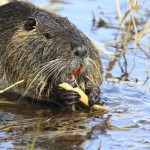Donkey-Powered Protesters March on Texas Capitol

Photo by Jeff Heimsath for KUT News
Marjorie Farabee was stopped from bringing her wagon to the steps of the capitol. But she did deliver around 100,000 signatures collected online to protest the burro killings.
Words matter in life. And the case of the the wild donkeys of West Texas is no exception.
If you call them “Wild Burros” you could be inclined to see them as scrappy survivors, emblems of the Old West. If you call them “Feral Donkeys,” well, then they sound like pests that need to be exterminated.
In Texas, what we have here is a failure to communicate.
If you were near the State Capitol Wednesday, you got a first-hand glimpse of the fight heating up between the two camps. Six donkeys (including “Miss Abby,” a Donkey with her own blog), and about a dozen protesters were there to deliver a message to the Texas Governor: “Stop killing the wild burros of Texas.”
For years, the Texas Parks and Wildlife Department (TPWD) has had a policy of killing the burros. The donkeys were first introduced by early Spanish colonists in the 1600s. Today, the state views them as a dangerous invasive species, responsible for habitat destruction and the fouling of West Texas water sources (TPWD even has a webpage devoted to burro droppings found near water wells).
The Donkeys Were Here First
The riders, many of them from West Texas where burros are more common, see it differently.
“The burros have been there longer than Texas Parks and Wildlife,” says Rachel Waller Rondeaux from Alpine. She is a member of Red Horse Nation, a group devoted to wild horse protection. “I mean I think [Parks and Wildlife] is invasive, personally,”
Waller Rondeaux and others argue that the burros have lived in relative harmony with the Texas

Photo by Jeff Heimsath for KUT News
Gayle-Suzanne Barron brings a box of 100,000 signatures collected online to protest the killing of Burros to the offices of the governor and leutenant governor.
landscape since colonial times. They say the killing of burros has increased since a state program got underway to re-introduce longhorn sheep to West Texas. The state, they argue, wants to make money off the sheep hunting licenses.
“It’s all for the money,” says Waller Rondeaux.
That’s a charge Parks and Wildlife denies. Kevin Good, special assistant to the director of state parks, says the feral and exotic animal removal program has been in place since the early 1990s. If anything’s changed since then, he said, it’s been the population of wild donkeys.
“Due to the droughts and the down economy, people just can’t afford to take care of their animals anymore and they’ve turned them loose,” says Good.
“If you’ve got an animal like a burro that’s eating grass,” he says, “than obviously that’s grass that’s not available for an animal like a rabbit. And so if your rabbit population declines, that means less food for red tail hawks for instance.”
Cuter than Feral Hogs
But back at the state capitol, where visitors Josie Sinomano and her friends took turns petting one of the donkeys, the PR challenge of defending the state’s program came into full focus.
“[The donkey] is adorable!” said Sinomano. ” I like the way it was eating the mints and stuff. It’s cute.”
“Obviously some animals are more attractive to humans than others, but we try to separate cuteness from resource management.”
— Kevin Good, Texas Parks & Wildlife
When asked about the PR challenge of killing creatures that many find “adorable,” Good conceded that it’s a challenge.
“Obviously some animals are more attractive to humans than others,” he said “but we try to separate cuteness from resource management. That’s not a good science-based way to run a parks system.”
But Good said the department is open to changing its policy if a third party created a burro sanctuary in West Texas. Many of the protesters would prefer the donkeys continue to roam free, but they seemed open to the idea.
“That is a compromise, but at least they’re alive,” said Gayle-Suzanne Barron.
The state is in talks with the Humane Society about a potential burro sanctuary. But there is one serious stumbling block: Money. Texas Parks and Wildlife says the sanctuary would need to be funded by outside source.


